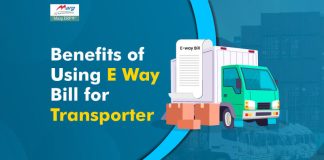Tag: ewaybill systems
5 Key Benefits of Using E Way Bill for Transporter
E-way bills are receipts or documents with details and instructions related to the shipment of goods consignment issues by the carrier and anybody can create an e way bill online easily. The details may include the consignor’s name, recipient, and the point of consignment’s origin, route, and destination. An e-Way Bills is an adherence mechanism
Where a person causes the movement of goods and the right information through a digital interface to be equipped before the movement of goods gets started and creates an E-way bill on the portal of GST.
What is the meaning of an E-way bill?
An E-way bill means an electronic waybill. The e-way bill will apply to the goods movements in inter and intra State Transportation. As the name suggests, it’s an electronic document created from the eway bill portal demonstrating the goods movement. It’s an obedience system under the GST through a digital interface for the person who causes the goods movement must upload the right details before the movement of goods starts and make an e-way bill on the GST portal.
It contains the following details-
Name of consignor
Consignee
The point of origin of the consignment
Destination details and
Route
E-Way Bill Requirements For Transporter
If a transporter needs to transfer goods from one means to another during transit then the transporter has to create a new e-way bill in Form GST EWB-01 before such transition.
Where the goods are carried from the area of the transporter to the business place and such distance is less than 10 kilometers, at that, time details of such vehicle (Transporter to Business Location) is not needed to be furnished.
If the transporter has to deliver consignments in bulk in a single vehicle then they may indicate a Serial No. of e-way bills created for all consignments and a consolidated E way bill in FORM GST EWB-02 can be generated before the goods movement.
If the sender has not made an e-way bill then the transporter must generate Form GST EWB-01 as per the invoice or bill of delivery or supply challan, if the goods’ value is more than Rs. 50,000.
The Commissioner may need a class of transporters to get a unique RFID (Radio Frequency Identification Device) to receive the said device underlined onto the vehicle and find the e-way bill to the RFID before the goods’ movement.
Now, let’s move on to explore the advantages of the e-way bill.
5 Top Advantages of E-way Bills Are Discussed Below:
A few key benefits of the e-way bill are listed below:
1. Less Documentation
No state-particular documentation would be required for goods transportation. The RGID device inside the carrier providing regular consignments is another perk for transporters. The driver is not required to carry the e-way bill’s physical copies as it’s mappable now and confirmed utilizing the RGIC device is in the vehicle, avoiding the inconvenience of carrying tangible documents.
2. Cost Reduction
Electronic billing removes management costs by accepting suitable invoicing and preventing tax avoidance. Additionally, the portion of logistics costs to GST is forecasted to go down, which is now relatively high compared to other countries.
3. Fast & Efficient Transportation
The introduction of the e-way bill has made the whole ewaybill systems faster and more efficient. It minimized the number of checkpoints that crossed national routes and state lines. Furthermore, it fulfilled the gap between around 85000 yearly average kilometers covered by Indian trucks and nearly 150000 to 250000 kilometers in already developed countries.
4. Simple and quick generation of e-way bill
The creation of e-way bills is done via the government-set online portal. However, the e way bill portal and e-way bill mechanism are simple and user-friendly. Through the system, it’s likely to be possible for dealers to a self eway bill generate, and it’s like a no bigger task nowadays. In the coming days, the procedure is anticipated to be more simplified so that a layman can generate an e-way bill and ease the movement of commodities.
5. Easy and Quick Generation
The generation of the e-Way bill process is simple and quick with an easy-to-use interface. In addition, this can assist in maximizing tax compliance through units covered under the GST administration.
When E-way bill is required?
When the goods movement is worth more than Rs. 50,000, the registered person bounds to generate an E-way bill before the goods movement starts. The reason for goods movement may be Supply, reasons besides supply or inward supplies got from a non-registered individual.
The E-way bill can be created even for consignments below Rs. 50,000.
The limit of Rs. 50,000 is not applied under the situations given below (An electronic bill is needed in each case):
1. When goods are delivered by the major interstate for the job task.
2. When handmade goods are sent interstate by an individual who has been liberated from the requirement of getting registration under clauses 1 & 2 of section 24 of the Act.
Who should generate an e-way bill?
Every registered...

